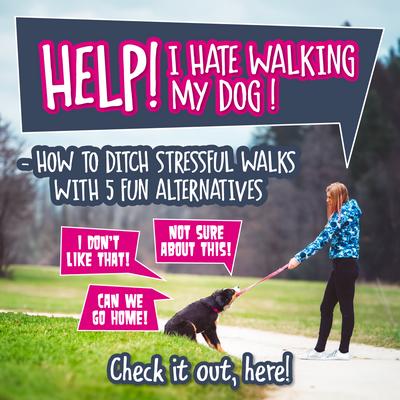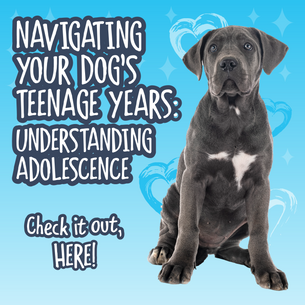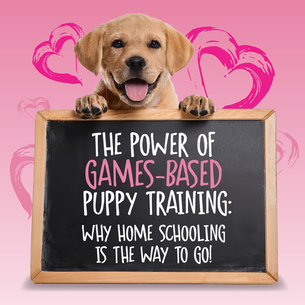"Walkies!” Daily walks are one of the best things about owning a dog, right? Those long leisurely strolls, your dog by your side. They’re part of the dog owning dream - a cherished part of dog ownership. In fact, there are few rules of dog ownership so enduring as the myth that you MUST walk your dog EVERY DAY! It’s such a basic principle that it’s practically set in stone.
But what if those daily walks are actually quite stressful - for you and your dog?
Some dogs thrive on daily walks. In fact, they just love them! But when you own an anxious or reactive dog - one who struggles to interact appropriately with other dogs, who barks at people, is worried by traffic, chases wildlife or finds the whole world a really stressful place to be - walks can quickly become something you dread rather than enjoy.
And here’s the thing. The more often you head out and have those same stressful, negative experiences, the more likely they are going to happen again. Rehearsal is powerful! Your dog will get better at running off after wildlife, you’ll increase the chances of them chasing the skateboarder, or disappearing after rabbits, or becoming more and more reactive or worried about meeting other dogs.
The more times your dog finds themselves in situations they don’t have the skills for, the more challenging those situations become. And the more stressful your walks become too.
Instead of those stress-free adventures you imagined, walks can become a part of your day that you dread.
Not only that, they can become something your dog dreads too!
Think about it for a moment. If your walks always look the same - battles with pulling on lead, relationship withdrawals because your dog doesn’t come back when called, reactivity or challenging encounters with other dogs that leave your dog feeling scared and overwhelmed - they’re going to be predicting those negative experiences long before you head out of the door. And everything that predicts a walk, from putting on your shoes and picking up the lead to grabbing the car keys or your treat pouch, means their stress bucket is filling at the mere thought of that walk!
Your walk is destined to fail before you even leave the house.
But what if it didn’t have to be that way?
What if you could provide your dog with the mental and physical enrichment they need without subjecting them to situations they find challenging? Even better, what if you could equip your dog with the skills needed to make stress-free walks a reality?
Join us as we provide you with the solutions you need to transform your walks, so that heading out with your dog for stress-free adventures isn’t simply the stuff of dreams.
Why Are Our Walks So Stressful?
Before you can transform your walks from stressful to stress-free, you need to understand just why those walks are so challenging.
Part of this is to do with the shape of your dog’s brain.
Some dogs simply don’t have the skills needed to handle the world they are part of. Your dog might be experiencing feelings of fear, frustration or overexcitement, all of which can cause them to struggle with the world and behave in a way that feels challenging, or frustrating, or which get them into trouble.
It’s also important to understand that, just like humans, dogs have stress thresholds. Imagine this as a bucket that fills up with every positive (exciting) or negative (scary or stressful) experience. Some dogs naturally have big buckets that fill slowly and empty quickly, while others have smaller buckets that fill quickly and empty slowly.
If your dog finds walks stressful because they are worried about meeting other dogs, or because they hate the sound of motorbike engines backfiring or the unpredictable bang of crow scarers, or because they’re quickly overwhelmed by how busy your neighbourhood is, or because something else about the experience dents their optimism, your daily walks will be filling their stress bucket.
Living with a constantly full stress bucket is detrimental to your dog’s quality of life. It puts stress on their bodily systems which can negatively impact their health. Not only that, it means their capacity to handle those walks is impacted, because they are much closer to the threshold at which that bucket overflows.
If you head out for a walk every day (sometimes more than once), your dog’s bucket never gets a chance to empty before something else fills it a little bit more. The result? Overload is quickly reached and unwanted behaviours occur. If your dog regularly barks and lunges at other dogs and people on walks, responds fearfully to traffic noises, unexpected objects in your path or even to things that seem pretty innocuous (a baby in a pram, a traffic cone at the side of the road), that’s an outward sign that their stress bucket is overflowing.
It might be that your dog loves their daily walks, but those walks are filling YOUR stress bucket to the max, because they regularly chase off after wildlife and ignore your recall, pull your arm out of its socket with their eagerness to get to that next great sniff, or rehearse another equally frustrating behaviour. And, of course, if your dog finds walks overwhelmingly exciting, their stress bucket will fill with every outing too.
Either way, it’s a sign that your dog doesn’t currently have the skills they need to head out on a walk and make the very best choices.
Permission to Not Walk Your Dog!
That’s right! We’re giving you permission to ditch those stressful walks!
Does that come as something of a relief?
Every dog needs mental and physical enrichment. Yet the reality is that there are so many other ways you can provide your dog with rewarding, fulfilling experiences and grow your relationship at the same time.
Once you open your mind to the possibility of time spent with your dog being more than a daily walk, you open up a whole new world of opportunities.
You get to add more variety to your dog’s day AND take steps to inspire great behaviour through fun interactions with your dog, away from the situations they struggle with - all while boosting their skills and getting them real-world ready!
Ditching those stressful walks can be incredibly empowering, yet it’s vital that you also ditch any guilt or preconceived ideas that you must walk your dog every day.
Instead, celebrate the fact that you are stepping up as your dog’s best advocate and providing them with everything they need, without adding to their stress bucket.
The Benefits of Ditching Stressful Walks
Ditching your daily walks for a while can offer a really valuable long-term investment in your dog’s overall training and behaviour - and into your relationship. There are so many alternatives to taking your dog for a walk every day and the benefits of having a break from those stressful walks are immense. They include:
- The chance to work on growing behaviours and boosting concepts at home, away from environments that are too challenging for your dog’s current skills.
- Time to empty everyone’s stress buckets (yours included!).
- An opportunity to learn some fitness games, or to put your dog’s nose to work with some scent games.
- A chance to limit rehearsal of unwanted behaviours.
- A focus on shaping your dog’s brain FOR the situation, not training IN the situation.
- More time to build a reliable recall in the safety of your home and garden.
- An opportunity to grow a calmer, more flexible dog by mixing up the routine.
- A chance to build positive socialisation experiences in safe environments where your dog’s emotional wellbeing is safeguarded.
- More time and opportunities for enrichment activities.
How Long Should You Ditch the Walk For?
This will be different for everyone. For some dogs, ditching walks for a few days of bucket emptying calm time at home can be all that’s needed.
Other dogs may need to ditch the walks for a little longer. You might find it becomes your way of life for a while as you work on growing the skills your dog needs to handle walks like a pro. This is training FOR the situation. It means your dog isn’t rehearsing less desirable behaviour choices, isn’t put in situations they don’t yet have the skills for, and you’re able to focus on growing those skills at home, without the pressure of those daily walks!
How Do You Know If It's Time to Ditch Your Dog's Walks?
Walks should be enjoyable, for you and your dog. If they’re not, it could be a sign that something isn’t quite right.
It can help to think of it like this: If 50% or more of your walks are challenging, because of excessive pulling, barking, lunging, poor recall, reactivity or signs of fear and overwhelm from your dog, reducing or stopping walks altogether is completely okay. In fact, it’s in your dog’s very best interests. And yours too!
Chances are your dog just doesn’t have the skills needed for successful, enjoyable walks right now - and repeatedly putting them in those situations is likely to make that worse, not better.
Evaluate your last 10 walks and identify how many were problematic. 5 or more? It’s time to give them a break!
Of course, taking a break from walks is just one part of the picture. You also need to be able to identify what skills your dog is missing that is making those walks so challenging, and make a plan to skill them up in those areas.
Take a moment to write down the main struggles you currently have on walks, and then identify the concepts your dog might be missing which could be at the root of that struggle.
For example:
Main struggle on walks: Overwhelmed and fearful in busy environments
Skills & concepts my dog needs to grow: Optimism and confidence
Main struggle on walks: Reactivity to other dogs
Skills & concepts my dog needs to grow: Optimism, calmness, disengagement
Not sure what concepts your dog might need? Find an overview of all the key concepts in the free Absolute Dogs There’s A Game For That: Zero to Hero! eBook
No Walks? What Do We Do Instead?
There are so many alternatives to traditional walks, which will not only eliminate all that stress, but will give you opportunities to power up your dog’s skills at home and in easier environments.
Here are five fun alternatives to daily walks that you and your dog can try.
Option 1: Trick Training
Are you ready to have an absolute blast with your dog, learn something new AND see the real-life benefits?
Trick training isn’t just fun - it’s an incredible way to turn tricky behaviour struggles into amazing strengths!
As well as being a lot of fun, training “tricks” can have surprising benefits for a whole array of dog behaviour struggles, and perfectly complement your everyday training.
In fact, we’re so passionate about the value of trick training for every dog, that we’ve dedicated a whole blog to it. Check out 5 Top Tricks Every Dog Should Know: Training For Fun and Practical Real-Life Skills.
Keen to give trick training a go? Grab one of our super trick-training solutions and discover HOW you can harness the power of tricks to transform your dog’s behaviour and unlock amazing real-life results!
Option 2: Fitness Games
A very natural concern when it comes to ditching walks is how to keep your dog fit and healthy and make sure they still get adequate exercise.
Every dog is a canine athlete, so fitness and conditioning should form part of your routine, whether you and your dog are heading out on daily adventures or are currently giving them a break.
And the bonus is there are so many fitness games which you can play at home with minimal space and equipment to keep your dog in tip-top physical condition, while also providing mental enrichment - and boosting concepts that will serve your dog well when you do head back out on adventures together.
Here’s a great one you can get started with:
Let’s Play: Bow
A bow, or bend, is a great trick for most dogs to learn. As well as being a lovely stretch which can be incorporated into fitness work, it encourages natural playfulness. A play bow is part of that instinctive repertoire of behaviours one dog can offer before interacting with another to help them through the interaction chain, so it can have real life value too!
Keep in mind that if your dog is new to this trick it will take time to build up the muscle strength needed to hold the position, so short, fun sessions with lots of breaks are important.
Step 1
Position yourself so you are facing your dog. Starting with your dog in a stand, hold a piece of food directly under their nose and lower it slowly downwards between their front legs towards their chest. Mark and reward any downward movement or effort your dog makes to bend at the elbows. Throw your food forward to reset them for another go, aiming to catch the moment just before they drop into a down.
Step 2
On each new go, aim to get your dog a little closer towards the bow position (elbows flat on the ground and bum in the air). Focus on tiny, tiny steps. This might start with your dog’s elbows bending, then gradually get closer and closer to their elbows touching the ground while their rear end remains high.
If you find your dog is dropping into a down, try rewarding them by releasing them out of the position to keep them moving.
Step 3
Once you can lure your dog into a bow in one smooth, fluid movement, add some duration by feeding in position.
Top Tip: If your dog struggles to work out that they need to keep their bottom in the air while lowering their front end to the ground, shaping the early stages of the behaviour under a chair or your outstretched legs can help your dog understand what position you’re asking them to find.
For more fitness ideas, check out our comprehensive 30 Days of Fitness course.
Option 3: Confidence Circuits
When walks are stressful, a key factor is often a lack of optimism and confidence.
Everything in your dog’s world could be good or bad, friendly or scary, depending on their level of optimism. Some dogs are born optimists, while others are naturally more pessimistic in their outlook.
Your dog’s level of optimism can influence how they feel about everything, including walks! Have you ever seen your dog startle at a familiar object placed in a new spot? Or get spooked by something unusual on a walk? Some dogs take novelty in their stride, while others can find it a little more challenging.
Confidence Circuits are a brilliant way to empower your dog to feel more confident about the world around them, and in turn, help transform reactivity and fearful behaviour - and they make a super alternative to walks, because as well as building trust and bravery and improving behaviour, they show you how to set up fun, enriching fitness courses built on the foundation of canine cavaletti exercises - without the need for lots of expensive equipment.
Building Confidence with Confidence Circuits
How do Confidence Circuits help build confidence? Here are just some of the amazing benefits.
- They teach your dog to work independently of any visual or verbal cues from you, instead taking their cues from the equipment you have set up. This is brilliant for encouraging your dog to solution-seek, try new things, interact with their environment and feel empowered to try new things - absolutely brilliant for dogs who need an optimism boost.
- As you and your dog work together, you will learn to tweak and adjust your Circuits to set your dog up for success, making sure they feel like a winner, every time!
- By encouraging your dog to explore new surfaces, navigate novel objects and move over, under, around and through a variety of obstacles, you are empowering them to try new things and building a powerful reinforcement history each time they do, which will transfer to other areas of your dog’s life too. The more your dog is encouraged to problem-solve and think through each adaptation of your Confidence Circuit for themselves, the more they will feel empowered to embrace new challenges in other areas of life. Learning increases your dog’s confidence and makes them feel like a winner.
- Confidence Circuits allow your dog to navigate your equipment independently, meaning that they are really and truly leading the learning. This is hugely empowering.
- Dogs have a huge mental capacity to learn, so building Confidence Circuits into their day is a great way to keep both their body and mind active and give them a brilliant mental workout as they learn ‘how’ to learn.
- Encouraging the controlled precision required for Confidence Circuits will help your dog learn to become more thoughtful about their movements in general, which will keep them safe and allow them to feel more confident in their own skin.
- Confidence Circuits are a brilliant way of building your relationship and connection, and a great way to learn to communicate effectively with your dog.
- Teaching your dog to move and control their body on different surfaces and navigate novel objects builds confidence and optimism too. The more aware your dog is of their own movements, the more confident they will be navigating different situations and novel environments they encounter in life too.
- Confidence Circuits are a brilliant way to work on your dog’s dimmer switch - that ability to pitch their arousal (energy) in a way that is appropriate to whatever situation they find themselves in. Dogs who are reactive to their environment, or who are quick to go from calmness to chaos with very little in between, benefit hugely from learning to regulate their energy and move more fluidly. By teaching your dog how to work within those levels of arousal that sit between calmness and craziness.
Option 4: Scentwork
The benefits of scent work for dogs are huge. Another great alternative to traditional walks, harnessing your dog’s natural instincts provides them with a super mental workout and offers endless enrichment possibilities.
Scent work is particularly valuable for reactive, Naughty But Nice dogs and those lacking confidence.
Studies have observed that scent work can increase optimism and confidence, as well as growing independence.
Seeking and play both release the brain chemical dopamine – that ‘feel good’ chemical which makes your dog feel great and which can help reduce anxiety.
Studies have also shown that scenting lowers a dog’s pulse rate. The higher the intensity of sniffing, the lower the dog’s pulse. What does this mean? Sniffing has a calming effect. This is great news for anxious dogs!
Scent can switch a dog from a fear headspace to one of seeking out reward.
It also gives your dog a job and builds their confidence as they increase their skills and work for reward.
Its benefits really aren’t to be sniffed at!
Keen to get started in scent work? Check out our blog Scentwork Dog Training Games You Can Play At Home for some brilliant, easy to implement games - and get ready to unleash your dog’s superpower!
Option 5: Training Games
Of course, the ultimate aim of ditching stressful walks is to open up a window of possibility within which you can boost your dog’s skills, reshape their brain and boost all those concepts they might currently be missing, which are at the root of those stressful outings.
This is training FOR the situation - the very core of games-based concept training and a fundamental aspect of the way we train here at Absolute Dogs.
If you’re brand new to games based training, our Sexier Than A Squirrel Dog Training Challenge is a brilliant place to start.
A perfect introduction to games-based training or a brilliant way to reinvigorate your training and make progress towards your goals, you'll discover quick and easy-to-understand games that fit into any schedule, work with any dog and provide noticeable improvements in training and behaviour struggles from the very start!
And the best bit? You get exclusive access to a community of other dog owners who are working through the same games at the same time - supported by a team of experienced dog owners and Pro Dog Trainers, ready to offer help and support.
Take up the Sexier Than A Squirrel Dog Training Challenge today, conquer your dog training struggles and achieve your training goals!
Sign me up!
Re-Imagining the Walk
It can be easy to fall into the trap of thinking a walk has to look a particular way.
Perhaps you typically head out of the house on foot, or hop in the car and drive to a particular spot. You probably have a route in mind. Your dog might get to enjoy some off lead time.
Depending on the reason you’re considering ditching those walks, you may be more familiar with venturing out at unsociable hours, jumping behind hedges to avoid approaching dogs, and desperately hoping to get home without clocking up too many reactivity episodes.
What if you could reframe how you and your dog see a walk?
When you boil it down, a walk is simply a step by step of events, or a ‘loop’ starting and ending at the same point. That might be your house, or the car.
If you and your dog can venture out and only rehearse optimism and build easy wins, and nothing bad happens – over time you can rebuild the picture of what a ‘walk’ is. That’s pretty empowering!
A circuit, or training walk, should represent everything you want in your walks, where your dog only rehearses feeling great about the world, and making super choices.
This might begin as something as simple as stepping outside, rewarding your dog for being able to focus on you rather than on the environment, and heading back inside.
Next time, you might get a little further. If your dog is particularly worried about novelty and lacks confidence, you might take some of the super optimism games you’ve learned at home and play them in front of your house, then head inside again with your dog feeling like a superhero!
Or you might head out in the car to a quiet car park, away from dogs or other potential triggers, and work on your dog’s new-found skills somewhere a little more challenging.
The key is to make sure your dog only rehearses feeling great about the world, and making super choices.
Reintroducing Walks
Ditching the walks doesn’t have to be forever.
As you build your dog’s skills you’re going to boost their confidence about the world.
Over time, you can increase the length of your walks, and go to places with more distractions, more people and more dogs - because your dog will have the skills to handle those situations and behave appropriately.
As you prepare to reintroduce walks, it’s important to be intentional and thoughtful about how you bridge the gap and take your dog’s training from home to the real world. Set your dog up for success.
Consider gradual exposure to challenging situations. Work at a safe distance from triggers, use parallel situations to stretch your dog’s learning, and take your training games to different environments.
Before you know it, you’ll be able to head back out on your daily walks and they’ll be full of wins and positive experiences, rather than being something you and your dog dread.




